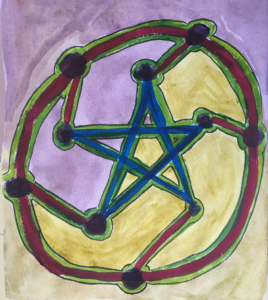 If I tell someone that my favorite branch of math is graph theory, communication seldom occurs. People think I take delight in jagged lines and pie charts. They are all too happy to change the subject.
If I tell someone that my favorite branch of math is graph theory, communication seldom occurs. People think I take delight in jagged lines and pie charts. They are all too happy to change the subject.
It’s an understandable misunderstanding.
The meaning of the word graph in graph theory is related to the word graphic. The graphs of graph theory are little pictures, real or imagined. They are made entirely of dots and the lines you can draw to connect them.
Draw a bunch of dots. Think about the different ways you can connect them. Suddenly you are doing graph theory.

Graph theorists draw graphs, or imagine them, and ask math-y questions about them. Those would be questions like:
- How can I describe this?
- Are these two the same?
- What makes these two different?
- Is there anything to count here?
- Can I combine these two?
- Can I take this apart?
- Are there others like these?
- Is there a pattern?
- Are there patterns in the patterns?
One way to get started in graph theory is to draw a random graph—dots connected by lines—and invent a game you can play on it. You can draw it on paper, or with chalk on a sidewalk. Invent some rules. Decide how the game finishes. Try it out. If it is too easy or too hard, change it.
You might already know some games that are like this. (Can you play tic-tac-toe on a graph? Checkers?) You can change the graph or change the rules to get a different game. As you figure out which games are good ones and develop strategies for playing, you will be doing lots of graph theory.
Here is some of the official mathematical vocabulary of graph theory:
- Vertex is a fancy word for dot.
- The lines are called edges
- The distance from one vertex (dot) to another is the number of edges (lines) you have to travel to get there.
- The degree of a vertex (dot) is the number of edges (lines) that touch it.
If you want to talk to someone (or yourself) about graphs that interest you, words like these will come in handy.






